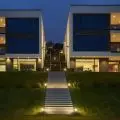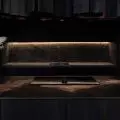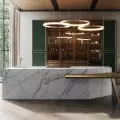A revolution is in the pipeline in Poznan - after a century of operation, the Poznan International Fair will cease to be an isolated enclave and partially open up to the city. They will show their next incarnation to Poznań residents passing by. Because the fairgrounds are undergoing a constant transformation of architectural matter. Not always for the better.
There is no other place in downtown Poznań that undergoes transformations as often as the MTP area. Since the first Poznań Fair of 1921, which was set up on the site of the East German Exhibition a decade earlier, almost everything here has changed. Not only are many of the pre-war buildings missing, but also the very fine buildings from the first decades of the communist era. Also gone are the dense stands of trees that were the remnants of the Jewish and two Catholic cemeteries. These necropolises were liquidated by the Germans during the war, and after 1945 the territorially limited MTP eagerly absorbed these extensive green areas.
Few city residents, however, are aware of the changes taking place at MTP. The fair - an isolated and inbred area in the center of the city - for decades allowed in only guests of events held here. But they too were more focused on the expositions than the architecture. It's only been a few years that MTP has been inviting locals to "Summer at the Fair," organizing, among other things, an urban beach, an open-air cinema and sports fields. Unfortunately, despite many approaches and concepts, the past decades have failed to better integrate the Fair with the neighboring Central Station. Worse: for the past nine years, the railroad has been operating a new pseudo-station fused with the Avenida shopping center, even further away from the Fairgrounds.
{View of the main entrance to the MTP (designed by Studio ADS) from the Dworcowy Bridge},title=View of the main entrance to the MTP (designed by Studio ADS) from the Dworcowy Bridge}.
A view of the main entrance to the MTP (designed by Studio ADS) from the Station Bridge. Until 2006, this panorama was more strongly dominated by the now obscured "spire" (1955, designed by Boleslaw Szmidt).
Photo: Jakub Głaz
The real, year-round opening of MTP should take place in the next several months. Poznaners will finally gain a shortcut leading through the Fair from the western exit of the Central Station to Wilson Park in the Lazarz district. On the way they will pass, among others, a new square with an urban function, under which MTP will build a three-story parking lot (designed by Śniadek + Śniadek Architekci). The project was supposed to be completed in a flash and open this fall, but more than a week ago the contractor, Pekabex, abandoned work on the parking lot, explaining it was due to incomplete documentation received from the Fair.



General view of the plaza designed over a three-story underground parking lot. Bottom left: entrance to the parking lot from Glogowska Street. On the left: neo-baroque administrative building with "belvedere" (1924), entrance to the planned walkway through the MTP area, pavilion 2 (1929). On the right - the former Fair Palace (1924). In the background, the existing green square by the Poznań Congress Center.
proj. Śniadek +Śniadek Architekci, source: MTP
The parking lot and plaza will therefore be built with a slip - creating a new urban space, intended, among other things, for the food gardens of the establishments to which MTP would like to make available Hall No. 2 (1929, designed by Roger Slawski, rebuilt and modified in 1947), adjacent to the plaza. On the planned route towards the park, a successful green square with a terraced layout has already existed for seven years, adjacent to the Poznań Congress Center building housing, among other things, the conference and auditorium Hall of the Earth for two thousand spectators (1994, designed by Wojciech Tkaczyk, expanded to include the Hall of the Earth: 2012, designed by Studio ADS).
Further on, an internal street leads uphill to Wilson Park and Sniadeckich Street, from which a very interesting panorama of the downtown area can be seen. Along the route of the new walkway there are also two buildings from 1924, which deserve a thorough renovation and restoration to their pre-war damaged condition. We're talking about Stefan Cybichowski's design: the neo-Baroque administrative building opposite the train station and the classicizing former Market Palace serving as a workshop today.



The entrance to the Fairgrounds opposite the Western Station building. A public walkway for residents will begin here. On the axis one can see a fragment of the former Fair Palace (1924, designed by Stefan Cybichowski) truncated during the post-war reconstruction and used today as workshops.
Photo: Jakub Głaz
The Fair had been maturing for a long time and was rather reluctant to open the grounds more widely. They explained it by problems with logistics and event handling. The approach began to change slowly only six years ago, when the city took over all the shares in the company (previously 60 percent belonged to the Treasury). As of 2018, MTP was even paying a "development strategy coordinator" for 12 months to influence the integration of the Fair into the city environment. However, the opening of the Fair's passageway was decided by the formally modified local development plan for MTP (passed in 2019), or, more precisely, by a favorable amendment to the draft plan submitted by the Urban Planning and Architectural Commission. Thanks to it, new fair developments (including a parking lot) were linked to the need to make the MTP area accessible to residents.
Poznan - a fair city?
The underground parking lot is not there yet, but during the pandemic the parking space became partially the central square of the MTP (the so-called St. Mark's Square), serving, among other things, doctors employed at the Covidium Hospital. This facility now occupies part of the MTP buildings, serves patients and is one of the more prominent vaccination sites. The Poznań fair is thus celebrating its centennial at one of the strangest moments in its history. The pandemic reduced the number of events, exhibitions and conferences almost to zero. It was probably only worse after the war, when most of the MTP buildings lay in ruins, and in the early 1950s, when for political reasons the annual fair was not held and was threatened with liquidation.
The 


The main market square (St. Mark's Square) is today a purely utilitarian and unattractive space. From left: pavilion 3 and the main entrance to the MTP (2014, 2006, designed by Studio ADS), the Fair Center (1973), the "spire" or pavilion 11 (1955, designed by Boleslaw Szmidt).
Photo: Jakub Glaz
The pandemic crisis came at a time when - for several years now - the Fair was trying to evolve, in a reality in which the importance of exhibition events was declining, while the importance of conventions, congresses or events, such as the picturesque fantasy lovers' convention Pyrkon, was growing. MTP itself also ceased to be a showcase of Poznań, unlike in the communist era, when the association of Poznań as a fair city was almost automatic.
Not only has the fair ceased to be a symbol of the city, but it is no longer an enclave of interesting modern architecture. The permanent pavilions and halls erected after the war were often attractive exhibits in their own right. Admittedly, most of them were not as avant-garde as the facilities of the Center for Technical Progress in Katowice, but they still surpassed the quality of "civilian" developments in downtown Poznań. Most of these have disappeared irretrievably in the last two decades, giving way to new halls or combinations of old and contemporary buildings by Studio ADS (best known for its design of Poznan's Old Brewery).
Studio ADS started its trade fair projects with a high "C" before gradually slipping into mediocrity. In 1999, with their successful pavilion No. 3A, which cuts off radically from the postmodernism that was still reigning at the time, the architects replaced the post-war building adjacent to the so-called representative pavilion with a characteristic turret built for the General National Exhibition (1929, designed by Roger Slawski). They later realized the main entrance to the MTP in the form of a tall and rather overscaled glazed volume. While the building itself maintains a decent level, it was a mistake for it to partially obscure the post-war symbol of the MTP - the trade fair spire, which Boleslaw Szmidt built in 1955 on the basis of the Upper Silesian Tower (designed by Hans Poelzig, 1911), which was damaged during the war.


 .
.
"Spire" of MTP, built on the basis of Hans Poelzig's 1911 Upper Silesian Tower (1955, designed by Boleslaw Szmidt), visible from the fairgrounds from the north.
Photo: Jakub Głaz
Another work by Studio ADS was the so-called "four-pack," a combination of the old and new halls (7, 7A, 8, 8A) on Sniadeckich Street using passages with linden trees preserved inside, covered with an arched roof of wood and glass. The almost windowless pavilion No. 3, just off the main eastern entrance, can be considered the declining and weakest structure. The massive block gives a grim expression to both the adjacent Roosevelt Street and the main square of the Fair, the aforementioned "St. Mark's Square," which today is far from its former class.
The 


A complex of four pavilions (7, 7A, 8, 8A), the so-called four-pack, with a very characteristic and unique at MTP roofing of the inner green walkway (2008, designed by Studio ADS), view from Sniadeckich Street.
Photo: Jakub Głaz
The new developments, united by built-in connectors, are certainly more practical and better suited to the contemporary needs of exhibitors. Nevertheless, it is regrettable to see very well-designed buildings from the successful turn of the 1950s and 1960s for MTP. We are talking, among others, about the former "Soviet" pavilion with a hanging string roof (1961, designed by Jozef Jędrzejczak, Antoni Mizera, Władysław Lemański), which was demolished a decade ago, and the unique seven-story pavilion-point building (1962, designed by Jozef Jędrzejczak). If these buildings had been demolished in the open space of the city, there would probably have been protests. It was much easier to remove, without publicity, these unappealing buildings in the closed market area. Fortunately, it was possible to preserve and renovate the original and very successful 1949 Pavilion No. 10 - the first permanent modernist building on the MTP grounds. The intimate building designed by Boleslaw Szmidt now serves as the Press Center.



Pavilion No. 10 (today the MTP Press Office), the earliest permanent structure with a modernist form at MTP (1949, designed by Boleslaw Szmidt). In the background is Pavilion 4, a few years younger by the same architect, built in the Socialist Realist style imposed on designers at the time.
Photo: Jakub Głaz
ThePIF also suffers from a lack of greenery, including the aforementioned old-growth forest "which is a very characteristic element of the Poznań Fair," as the monthly magazine "Architektura" wrote in 1958, appreciating that the PIF "has thought not only about the commercial function, but also about the viewer, who after seeing thousands of square meters of exhibition should find a pleasant and secluded place to rest." Today there is a different atmosphere here. Fortunately, the return of greenery, and lots of it, was envisioned for MTP by the authors of some of the entries of the Skyline Challenge student architectural competition arranged two years ago by the Fair, the magistrate and two Poznań universities. At the same time, MTP also announced several new spot green additions.
The name of the competition signaled that the Fair wanted to go up - this was also served by the change in the development plan mentioned here. The design of the office building by CDF Architekci, which is to stand in the "high" zone on Bukowska Street (the plan allows 68 meters there), is already well advanced. Let's hope that it will make a horizontal reference to the best post-war models. It's time to reverse the trend in which it was not the Fair that influenced the quality of architecture in the city, but on the contrary , it was captured by Poznan mediocrity.







































































